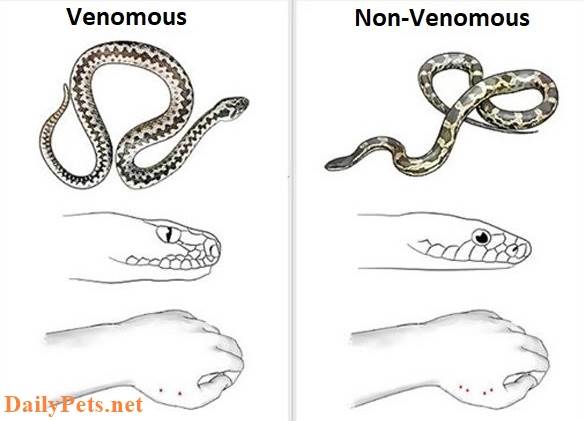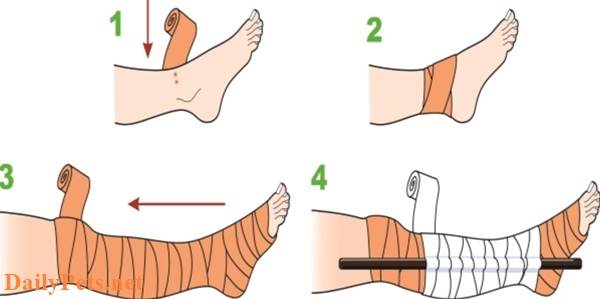The number of snakebite cases at healthcare facilities is on the rise because of improper first aid or the use of traditional remedies.
This can lead to patients experiencing tissue necrosis, loss of consciousness, bloodstream infections, or even death. Therefore, identifying poisonous snakebites and providing proper first aid is extremely important.
Recognizing Venomous and Non-Venomous Snakes
Distinguishing between venomous and non-venomous snakes can be challenging, but some common venomous snakes can be identified by their distinctive features: Russell’s viper (makes a characteristic hissing sound), the saw-scaled viper (with a saw-like pattern on its back), the krait (black and white bands), and some pit vipers (with large triangular heads).

Venomous snakes usually have two large fangs in the upper jaw, leaving characteristic double fang marks when they bite. Non-venomous snakes leave multiple rows of small teeth impressions. Venomous snake fangs are like hypodermic needles that inject venom under the skin or into the muscle.
First Aid for Snake Bites
First aid for snake bites should be administered immediately after the bite and before transporting the patient to a hospital.
The goals of first aid are as follows:
- Remove venom and slow its movement from the bite wound into the body. This can be achieved by cleaning the wound with clean water, applying a bandage (not too tight), immobilizing the bitten limb to reduce venom spread, and protecting the patient’s life by preventing and managing complications before reaching medical facilities.
- Transport the patient to a medical facility as quickly and safely as possible.
- Minimize harm to the patient.
Steps to be taken during first aid:
- Attempt to identify the snake species, noting its color, size, head shape, and attack behavior. If possible, take a picture of the snake or bring the snake to the medical facility.
- Keep the patient calm.
- Avoid letting the patient move. Immobilize the bitten limb using a splint.
- Use a bandage to immobilize the bitten limb in case of pit viper bites (such as saw-scaled viper, Russell’s viper, or king cobra). The bandage should be wrapped firmly, but not excessively tight, to restrict lymphatic circulation and slow venom spread.
- If the bite is from a krait or snake that doesn’t cause local bleeding, apply a tighter bandage to control bleeding. Krait venom can interfere with blood clotting, leading to prolonged internal bleeding in various organs.
- If the patient has difficulty breathing, perform artificial respiration (e.g., mouth-to-mouth or using available medical devices). If the patient shows signs of cardiac arrest, start CPR and wait for medical personnel to arrive.
- Ensure the bitten area is positioned lower than the heart to reduce venom flow toward the heart and central circulation.
- Transport the patient to a medical facility as soon as possible. If the patient is alert and responsive, they can be taken to a large hospital with specific snake antivenom within the first four hours. If the patient is unconscious or has neurological deficits, take them to the nearest medical facility.
- Any snakebite, even if believed to be from a non-venomous snake, should be treated and observed in the hospital for at least the first 12 hours. After 24 hours, the efficacy of treatment is significantly reduced.

Do not use the following methods:
- Do not use a tourniquet, as it may restrict blood flow and cause tissue damage.
- Do not cut or incise the bite site, as this may worsen the injury and lead to infection.
- Do not suck out the venom; it is unlikely to be effective and may introduce infection.
- Do not apply ice or immerse the wound in ice water, as it can worsen the damage.
- Do not use traditional or folk remedies, as they are often ineffective or harmful.
Preventing Snake Bites
- Be aware of the types of snakes in your area and their habitats.
- Wear protective clothing like boots and long pants, especially when walking in snake-prone areas at night, and consider wearing a wide-brimmed hat in snake-rich environments.
- Avoid handling snakes, attempting to catch or corner them.
- Do not live near snake-prone areas or habitats.
- Avoid catching snakes in fishing nets or fishing lines.
- Use a flashlight in the dark or at night.
- Do not provoke or harass snakes.















